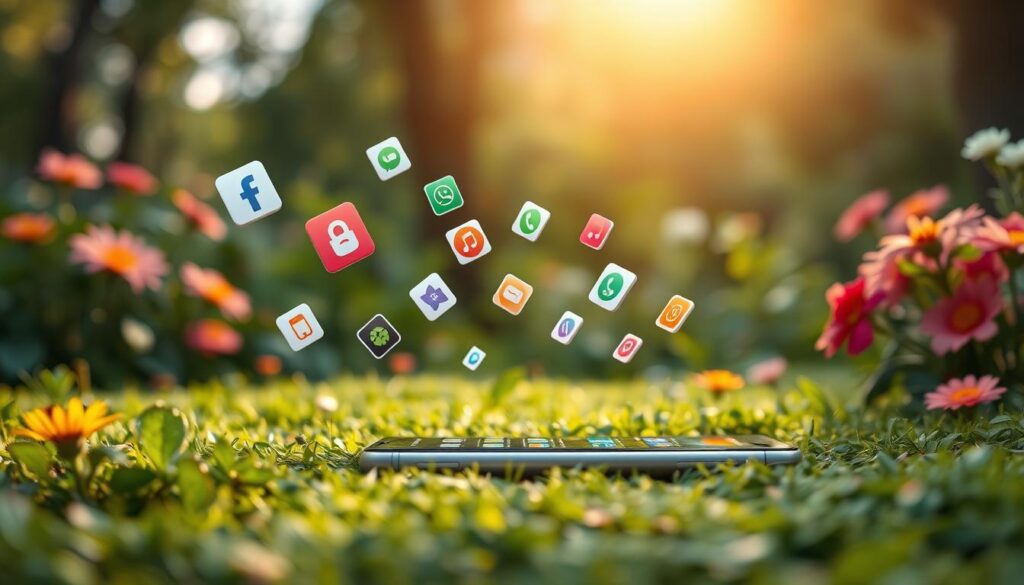A Modern-Day Anecdote
Digital Detox Challenges: Jessica, a 32-year-old marketing executive from New York City, was exhausted. Her daily routine revolved around constant Zoom calls, endless scrolling on social media, and replying to a flood of emails. Even her evenings, meant for relaxation, were consumed by Netflix marathons that left her feeling drained instead of recharged.
One evening, her six-year-old son innocently asked, “Mommy, why are you always on your phone?” That simple question hit her hard. It made her realize how disconnected she had become from her own life and family.
Determined to make a change, Jessica decided to try a seven-day digital detox challenge. What started as a daunting experiment turned into a life-changing journey. By the end of the week, she felt more present, her mind was clearer, and her relationship with her son grew stronger. If you’ve ever wondered how a break from screens could transform your life, Jessica’s story is proof it’s worth trying.
Key Takeaways
- Disconnecting from screens improves mental health and reduces stress.
- A digital detox strengthens relationships by fostering meaningful, offline connections.
- Planning ahead and setting clear rules are key to success in any digital detox challenge.
- The first few days may be difficult, but they lead to significant rewards like improved focus and emotional clarity.
- Embracing offline activities such as walking, journaling, and spending time in nature enriches your experience.
- Reducing screen time enhances sleep quality and boosts overall well-being.
- Starting small can help ease the transition into a screen-free lifestyle.
Why Digital Detox Challenges Are Necessary
The Overwhelming Impact of Screen Time
In the United States, adults spend an average of 7 hours daily on screens, according to recent data from Statista. Whether it’s working, chatting with friends, or unwinding with Netflix, screens dominate almost every aspect of our lives. Unfortunately, this over-reliance comes with hidden costs.
For instance, mental exhaustion often follows constant multitasking between work emails and social media notifications. Our brains become overwhelmed, making it harder to stay calm and focused. Similarly, sleep disturbances are another common issue.
The blue light from phones and laptops disrupts melatonin production, leaving us wide awake even after hours in bed. Additionally, excessive screen time strains relationships. Families and friends may share the same space but feel disconnected because everyone is glued to their devices. Over time, this can weaken emotional bonds.
How Screen Addiction Affects Your Brain
Research highlights how digital screens reprogram the brain’s reward system. Notifications trigger dopamine spikes—the same “feel-good” chemical linked to addiction. While this might feel satisfying in the short term, it leads to habits that are hard to break.
Over time, this rewiring impacts key brain functions like focus, creativity, and emotional regulation. Many people report difficulty concentrating on tasks or connecting with others emotionally. This constant overstimulation also reduces the brain’s ability to handle boredom, making us crave more screen time instead of meaningful activities.
A Quick Look: Screen Time Impacts
| Effect of Excessive Screen Use | Explanation |
| Stress | Multitasking and constant notifications increase cortisol levels. |
| Sleep Issues | Blue light disrupts the natural sleep-wake cycle. |
| Decreased Focus | Overstimulation makes it harder to concentrate on single tasks. |
| Weakened Relationships | Reduces face-to-face interactions and emotional connection. |
Digital detox challenges help break this cycle by giving your brain the reset it desperately needs. This not only improves mental clarity but also brings balance back into your relationships and daily life.

The Core Principles of Digital Detox Challenges
What Is a Digital Detox?
A digital detox is a deliberate break from digital devices like smartphones, laptops, TVs, and gaming consoles. The goal is to reduce dependency on screens and reconnect with real-world activities. By stepping away from devices, you can refocus on offline tasks that bring mental clarity, creativity, and a sense of calm.
What Happens During a Digital Detox?
Instead of endlessly scrolling or gaming, participants spend their time doing activities that don’t involve screens. Common alternatives include journaling, exercising, reading, or enjoying nature. For example, a morning walk can be a simple yet powerful way to clear your mind. Families often use this time to reconnect by playing board games or sharing meals without distractions.
Research from the American Psychological Association shows that reducing screen time improves mood, strengthens personal relationships, and lowers stress levels. This is because your brain gets a chance to unwind without constant digital noise.
Examples of Offline Activities
| Activity | Benefit |
| Journaling | Helps organize thoughts and reduce anxiety. |
| Exercise | Boosts endorphins, improving mood and energy. |
| Reading a Book | Stimulates the brain and increases focus. |
By embracing these simple activities, you can rediscover what it feels like to live in the moment. Digital detox challenges don’t just reduce screen time—they offer a pathway to a more balanced and fulfilling life.

Benefits of a 7-Day Digital Detox
1. Improved Mental Health
Taking part in digital detox challenges can significantly enhance your mental health. Constant notifications, emails, and social media updates contribute to anxiety and stress. A study by the American Psychological Association found that reducing screen time for just one week improved mental well-being by 23%. This happens because the brain has time to relax and recharge without the pressure of digital interruptions. As a result, many people report feeling calmer and more focused after just a few days of unplugging.
2. Better Sleep Quality
Screens emit blue light, which suppresses melatonin—the hormone responsible for sleep. Avoiding screens, especially at night, has been shown to improve sleep quality. According to research by Harvard Medical School, skipping screen time three hours before bed can enhance sleep quality by up to 50%. Deeper, more restful sleep boosts your energy and mood the following day, making this a key benefit of digital detox challenges.
3. Strengthened Relationships
Excessive screen time often pulls us away from loved ones, even when we’re physically present. During a digital detox, you can reconnect with family and friends on a deeper level. Whether it’s sharing a meal without distractions or enjoying meaningful conversations, time offline fosters stronger emotional bonds. It’s a great way to rebuild connections that may have been weakened by technology overuse.
4. Boosted Productivity
The constant ping of notifications can make it hard to focus, slowing down your progress on important tasks. When you step away from screens, you eliminate these distractions and regain control over your time. Many participants of digital detox challenges find they can complete their work faster and with better quality. This increased productivity often carries over even after the detox ends.
Quick Snapshot of Benefits
| Benefit | Impact |
| Improved Mental Health | Reduces stress and anxiety by eliminating constant digital interruptions. |
| Better Sleep | Enhances melatonin production, leading to deeper, more restorative rest. |
| Stronger Relationships | Encourages meaningful interactions with loved ones. |
| Increased Productivity | Minimizes distractions, improving focus and efficiency. |
By embracing a seven-day digital detox, you’re not just cutting screen time—you’re opening the door to a healthier, happier, and more connected lifestyle.

Digital Detox Challenges: Day-by-Day Breakdown
Day 1: The Struggle Is Real
The first day of digital detox challenges often feels like stepping into unfamiliar territory. You might instinctively reach for your phone or laptop, only to stop yourself. This can make you feel restless or even anxious. These reactions are normal and show how deeply technology is ingrained in daily life. To ease this transition, replace screen time with simple activities like journaling or reading a favorite book. A long walk outdoors can also help clear your mind and break the habit of reaching for a device.
Day 2: Adjustment Begins
By the second day, you’ll notice a slower pace in your day. Without constant digital distractions, time feels more abundant. Use this opportunity to organize your space, declutter your home, or start a new hobby. Whether it’s sketching, cooking, or gardening, these offline activities will keep your mind engaged. Adjusting to life without screens may still feel odd, but you’ll start to appreciate the quiet moments.
Day 3: Emotional Clarity
On the third day, emotional clarity begins to emerge. Without the digital noise cluttering your mind, you might notice feelings or thoughts that have been buried under endless notifications. This is a great time to meditate, reflect, or practice deep breathing exercises. Embrace these emotions—they are part of your journey toward balance. Studies show that mindfulness practices during a digital detox can reduce anxiety by up to 30%.
Day 4: Focused and Creative
By Day 4, the fog of distraction starts to lift. You’ll find it easier to focus on creative or personal projects. Whether it’s painting, writing, or even rearranging your living space, this newfound clarity can spark a surge of productivity. Many participants in digital detox challenges report discovering hobbies they’d forgotten about or learning something new.
Days 5–7: Energized and Connected
As you near the end of the week, the benefits of a digital detox become more evident. Your energy levels improve, and your relationships feel more meaningful. Spend this time engaging with loved ones, planning a family game night, or simply enjoying tech-free meals together. The connections you build during these moments often leave a lasting impact, reminding you of what matters most.
Table: Visualizing the Digital Detox Journey
| Day | Emotional State | Recommended Activity | Key Tip |
| Day 1 | Overwhelmed, Fidgety | Take a nature walk | Avoid looking at other screens. |
| Day 2 | Slightly Restless | Start journaling | Reflect on what screens mean to you. |
| Day 3 | Calm but Emotional | Meditate or do yoga | Embrace the emotions fully. |
| Day 4 | Focused | Work on a creative project | Explore hobbies you’ve neglected. |
| Days 5–7 | Energized, Connected | Spend time with loved ones | Plan a tech-free family activity. |
By following this structured day-by-day plan, digital detox challenges can help you break free from the grip of screens and rediscover what life feels like without constant distractions.

Tips to Succeed in Digital Detox Challenges
1. Set Clear Rules
The foundation of any successful digital detox challenge is setting clear rules. Decide in advance which devices you’ll avoid during your detox. For example, you might choose to stay off your smartphone, laptop, or social media apps entirely. Make sure to share these rules with friends and family so they understand your goals and don’t unintentionally interrupt your progress. According to experts, clear boundaries significantly increase the chances of completing a digital detox.
2. Create a Digital-Free Zone
Designating areas in your home as “digital-free zones” can work wonders. A good starting point is the dining table or the bedroom. Keeping screens out of these areas encourages quality family time and promotes better sleep. Research by the National Sleep Foundation reveals that avoiding screens in the bedroom improves sleep quality by up to 47%. These zones become sanctuaries for relaxation and connection, free from the distractions of technology.
3. Plan Offline Activities
Preparation is key to enjoying your screen-free time. Create a list of offline activities you’d like to explore during your detox. Engaging activities could include reading a physical book, playing board games with your family, or starting a small gardening project. Planning these activities in advance helps prevent boredom and ensures your digital detox is both enjoyable and productive.
Table: Fun Offline Activities During Digital Detox Challenges
| Activity | Benefits |
| Reading books | Boosts focus and imagination |
| Playing board games | Strengthens family relationships |
| Gardening | Promotes relaxation and mindfulness |
| Journaling | Helps process emotions and reflect |
4. Use Accountability Partners
Accountability partners can make a significant difference during your digital detox. Share your plans with a trusted friend or family member who can help keep you on track. Having someone to discuss your progress with and celebrate small wins adds motivation. Many people find that partnering with others turns digital detox challenges into a fun and supportive experience.
By following these practical tips, you’ll be well-equipped to complete your digital detox and experience its full benefits.
“Almost everything will work again if you unplug it for a few minutes, including you.” – Anne Lamott

Key Challenges During a Digital Detox
1. Fear of Missing Out (FOMO)
One of the most common challenges of digital detox challenges is the fear of missing out (FOMO). Many worry they’ll miss social media updates, trending news, or important conversations. This anxiety can create a feeling of disconnection, especially for those who rely on social platforms for personal or professional updates. However, studies suggest that taking breaks from social media reduces stress and allows you to focus on meaningful offline interactions.
2. Productivity Concerns
Another major concern is the fear of falling behind at work or missing urgent emails. While this can feel overwhelming, proper planning can alleviate the worry. For example, setting up email autoresponders and notifying colleagues in advance ensures smoother communication. Research from Harvard Business Review indicates that short breaks from work screens improve focus and efficiency, proving that unplugging doesn’t mean compromising productivity.
3. Habitual Triggers
Breaking the habit of instinctively checking your phone is a challenge for most people. The habit is often deeply ingrained, with muscle memory driving you to reach for your device even when it’s unnecessary. A survey by Deloitte found that the average American checks their phone 96 times per day. Overcoming these triggers requires mindfulness and substituting screen time with engaging offline activities, such as journaling or exercise.
Table: Common Challenges and Solutions in Digital Detox Challenges
| Challenge | Impact | Solution |
| Fear of Missing Out | Anxiety about being disconnected | Focus on meaningful offline time |
| Productivity Concerns | Worry about work delays | Plan tasks ahead |
| Habitual Triggers | Muscle memory drives phone usage | Replace habits with hobbies |
By recognizing and preparing for these challenges, you can confidently approach digital detox challenges and embrace the positive changes they bring.
How to Overcome Detox Challenges
Managing FOMO
The fear of missing out (FOMO) can be overwhelming during digital detox challenges, but shifting your focus can help. Concentrate on enjoying the present moment, like meaningful conversations, nature, or hobbies. A study by Psychological Science revealed that individuals who disconnect from social media experience increased mindfulness and emotional well-being. Think of this detox as an opportunity to deepen personal connections rather than worrying about online updates.
Tackling Productivity Concerns
Worried about falling behind at work? Advance planning can make all the difference. Inform colleagues and clients about your digital detox challenges, and set up autoresponders for emails. Schedule important tasks before starting your detox. According to Inc. Magazine, time away from screens boosts productivity by improving focus and reducing burnout. Proper preparation ensures your work remains unaffected while you recharge.
Breaking Habitual Triggers
Overcoming the habit of reaching for your phone requires a proactive approach. Keeping devices out of sight, such as in a drawer or another room, reduces temptation. Engage in offline activities like exercising, reading, or gardening to fill the void. Studies from Deloitte show that breaking the cycle of habitual device usage takes just a few days with intentional effort.
Table: Strategies to Overcome Digital Detox Challenges
| Challenge | Impact | Solution |
| Fear of Missing Out | Feeling disconnected | Practice mindfulness and embrace the present |
| Productivity Concerns | Anxiety over unfinished tasks | Notify colleagues and schedule ahead |
| Habitual Triggers | Difficulty resisting devices | Keep devices out of reach, stay engaged |
By addressing these challenges thoughtfully, digital detox challenges can become a fulfilling journey toward better mental clarity and overall well-being.
“You don’t have to be anti-technology to be pro-humanity.” – Simon Sinek

Lists to Help You Disconnect
Activities to Fill Your Time
Taking a break from screens can feel daunting at first, but filling your time with enriching activities makes it easier and more enjoyable. Consider these:
- Hiking or Walking: Reconnect with nature and enjoy the calming effect of fresh air. Even a 30-minute walk can improve mental clarity.
- Cooking New Recipes: Experimenting in the kitchen is a fun way to stay engaged. Plus, preparing fresh meals benefits your health.
- Writing Letters to Loved Ones: Rediscover the art of handwritten communication. It’s personal and meaningful.
- Knitting or Crafting: Creative hobbies like these are therapeutic and a great way to express yourself.
Things You’ll Notice During a Detox
After a few days of stepping away from devices, you’ll begin to experience noticeable changes:
- Improved Focus: Without constant distractions, tasks are completed more efficiently.
- A Deeper Connection to Nature: Spending more time outdoors sharpens your senses and appreciation for the world around you.
- Rediscovered Interests: Old hobbies like painting or reading suddenly feel exciting again.
- Reduced Mental Fatigue: Your brain feels refreshed as you break free from digital overload.
The Role of Family in Digital Detox Challenges
Why Family Matters
Family can be your strongest support system during a digital detox. When everyone participates, the journey feels more collaborative and rewarding. Involving family strengthens relationships and builds lasting memories.
Group Activities to Try
Plan screen-free family activities, such as:
- Game Nights: Enjoy board games or puzzles together, encouraging laughter and teamwork.
- Picnics: A simple outdoor meal fosters conversation and bonding.
- DIY Projects: Build or create something as a team, like a garden or home decor.
Statistics Show the Impact
Research by Common Sense Media reveals that families who reduce screen time experience a 30% improvement in communication and emotional connection. Shared experiences during a detox also help develop healthier habits for everyone involved.
Table: Ideas for Family-Friendly Activities
| Activity | Benefits |
| Game Nights | Encourages teamwork and bonding |
| Outdoor Picnics | Promotes relaxation and fresh air |
| DIY Projects | Builds collaboration and creativity |
| Evening Walks | Combines fitness with conversation |
By filling your time with meaningful activities and engaging your family, digital detox challenges become a fulfilling and transformative experience.
“The quieter you become, the more you can hear.” – Ram Dass
Final Thoughts
Jessica’s journey through her seven-day digital detox challenge was nothing short of life-changing. By the end of the week, she felt deeply connected to her son and rediscovered a sense of balance in her life. The absence of constant notifications and screen time allowed her to appreciate the beauty of being fully present in the moment.
This transformation isn’t unique to Jessica—it’s something you can experience too. A digital detox challenge might feel intimidating at first, but the benefits far outweigh the initial discomfort. It’s an opportunity to clear your mind, nurture relationships, and embrace activities that bring you joy and peace.
Take that first step today. Commit to just one day without screens, and let it grow into a week. Your mind, body, and relationships will thank you for it. Start your journey now and unlock the potential of a more mindful, connected life.
FAQs (Frequently Asked Ques)
FAQ Session 1
Digital detox challenges can be difficult due to the habit of constant device use. Common challenges include feelings of FOMO (Fear of Missing Out), anxiety about missing important updates, and productivity concerns for work. Additionally, the habit of checking screens frequently is hard to break, and it may cause withdrawal symptoms.
While beneficial, a digital detox can feel isolating as you disconnect from social media and digital networks. People may experience difficulty adjusting to offline life, leading to feelings of boredom and disconnect. Some may also miss out on crucial work updates or social interactions, creating anxiety.
A digital detox challenge involves taking a break from digital devices, including smartphones, laptops, and televisions. The goal is to disconnect from digital distractions and focus on offline activities like journaling, walking, or spending quality time with loved ones. It’s typically done for a few days to a week, but some may choose longer periods.
Digital detox can be hard because technology addiction is deeply ingrained in modern life. Many people rely on their devices for work, socializing, entertainment, and staying informed. Dopamine from notifications creates a cycle of addiction, making it difficult to unplug. Additionally, there’s often the fear of missing out or falling behind on responsibilities.
Psychologically, a digital detox can help reduce stress and anxiety. Disconnecting allows the brain to rest and reset, leading to improved focus, better sleep, and emotional clarity. Over time, it can also foster a sense of calm and mindfulness, allowing individuals to reconnect with their emotions and mental health.
FAQ Session 2
To survive a digital detox, plan ahead. Set clear goals and rules, like which devices to avoid. Engage in offline activities such as reading, walking, or exercising. Having an accountability partner can also help you stay on track. Gradually reduce screen time before starting the detox to ease the transition.
After a digital detox, you may feel refreshed and rejuvenated, with a clearer mind. Many report feeling more connected to their environment and loved ones. Physically, you might experience improved sleep and reduced mental fatigue. Emotionally, a sense of peace and balance is often restored.
The length of a digital detox can vary based on individual goals and needs. A typical detox lasts between 3 days and a week. However, some people may choose a longer detox period, such as 30 days or even more, depending on their level of dependency on technology.
Yes, a digital detox is definitely worth it. It offers numerous benefits, including improved mental health, better relationships, and increased productivity. It helps restore balance, focus, and clarity in life. While challenging at first, the long-term rewards, including reduced stress and more fulfilling interactions, make it highly beneficial.
The stages of a digital detox usually include:
1. Initial withdrawal: Anxiety or restlessness as you disconnect.
2. Adjustment: Starting to adjust to a slower pace of life without screens.
3. Emotional clarity: As the digital noise clears, emotions and thoughts become clearer.
4. Renewed energy: Increased productivity, creativity, and energy as you embrace offline activities.
5. Reflection: Realizing the benefits of unplugging and how to incorporate balance into daily life.








[…] goal of a digital detox is to reduce screen time and focus on improving your mental, emotional, and physical well-being. […]